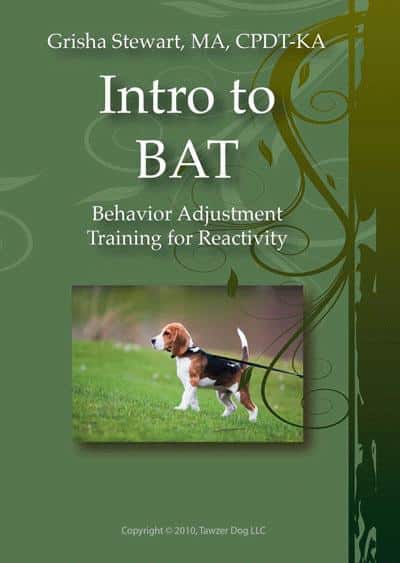As many of you may know, my rescue Beagle, Duke, is dog reactive. Initially, he was fearful and aggressive towards dogs in all settings (off leash, on leash, at the dog park, anywhere!) and before we began working with him, the mere smell of a dog (a dog’s scent lingering in the hallway of our condo even thirty minutes earlier) would trigger a howling fit.
At the time, the commonly prescribed approach to address dog reactivity was to train alternate behaviors (Watch Me, ignore the dog) and also desensitize and classically counter-condition new feelings towards dogs. Books like Feisty Fido by Patricia McConnell and Karen London, Fight! by Jean Donaldson, and Click to Calm by Emma Parsons covered these protocols in great detail and are very well-read in my library.
Next, Control Unleashed by Leslie McDevitt introduced another tool – rewarding the dog for looking at the scary/hated dog and putting that on cue with “Look at That!”.
Along the way, we got Duke’s reactivity down to a point where walks became sane again and Duke was able to return to attending group obedience classes. But, after nearly four years of working with him, his reactivity is reduced, but not cured, and he is what I’d call “manageable”, but still requires a lot of management. Many dogs (including ones I’ve been hired to help with) DO become “cured” from this work but Duke isn’t there yet.
While completing my studies with the Karen Pryor Academy, Casey Lomonaco of Rewarding Behaviors Dog Training introduced me to a new technique for rehabilitating aggressive dogs called Behavior Adjustment Training (BAT). Created by Grisha Stewart of Ahimsa Dog Training in Seattle, BAT is a protocol that uses operant conditioning to help dogs learn socially acceptable ways to deal with things that scare them (dogs, people, objects, etc.)
Recently, I ordered and viewed Grisha’s first DVD on the subject – Behavior Adjustment Training (BAT) for Fear and Aggression from Dogwise.com. This DVD is a live recording of a lecture she did on BAT in Novato, California, in January 2010. It is NOT intended for average dog owners (its way too dog-geeky) but is a perfect watch for professional dog trainers and behaviorists that have a solid understanding of operant conditioning and classical conditioning.

BAT for Fear and Aggression DVD
In a nutshell, Grisha explains that reactive dogs have learned that lunging and barking sends scary things away. Either the handler, due to embarrassment and wishing to stop the dog from rehearsing unwanted behaviors, backs away and creates distance when their dog reacts – or the scary thing (the other dog owner, for example), leaves because they are afraid of the lunging dog.
In dog-geek terms, using the Antecedent-Behavior-Consequence model we have:
- Antecedent = Scary Dog is approaching
- Behavior = Bark, Lunge, Growl
- Consequence = Scary Dog goes away
BAT is all about changing this sequence to:
- Antecedent = Scary Dog is approaching
- Behavior = Any calming signal or distance increasing body language – look away, sniff the ground, turn away, scratch, yawn
- Consequence = Scary Dog goes away.
There are three stages of BAT, which I won’t go into detail with here – but in its third, purest stage, no food or toys are used. The simple functional reward of being allowed to leave by offering an appropriate calming signal is the sole reward.
When I first heard about BAT, I found the concept interesting, but I am delighted to say that with some preliminary exercises I did with Duke, the results have been quite positive. Today, by coincidence, just before completing this blog entry, I had a chance to work with a reactive dog client with some ad-hoc BAT exercises at the nearby dog park. Both of us were extremely pleased with the progress we were able to make in decreasing distance and keeping the dog calm and under threshold. The relaxed body posture and demeanor of the reactive dog was significantly different than when we previously were using traditional food-based classical counter-conditioning techniques. The dog’s owner commented on our swift progress and how much her dog seemed to “enjoy the game” of BAT.
I look forward to working more with BAT and sharing this new technique with the reactive dog owners in our community.
For average dog owners wishing to learn more, Grisha has put out a second DVD called Organic Socialization that appears to be better filmed and presented in a way that average dog owners can absorb and comprehend the information. That being said, for this or any other aggression issue, consult a positive reinforcement trainer or behaviorist that has a solid understanding of operant conditioning and classical counter-conditioning when you get started.
Here is a short clip from Organic Socialization including a brief clip from a real life BAT session:
Learn more about BAT here:
http://ahimsadogtraining.com/blog/bat/
And discuss BAT and similar techniques on this Yahoo! Group:
